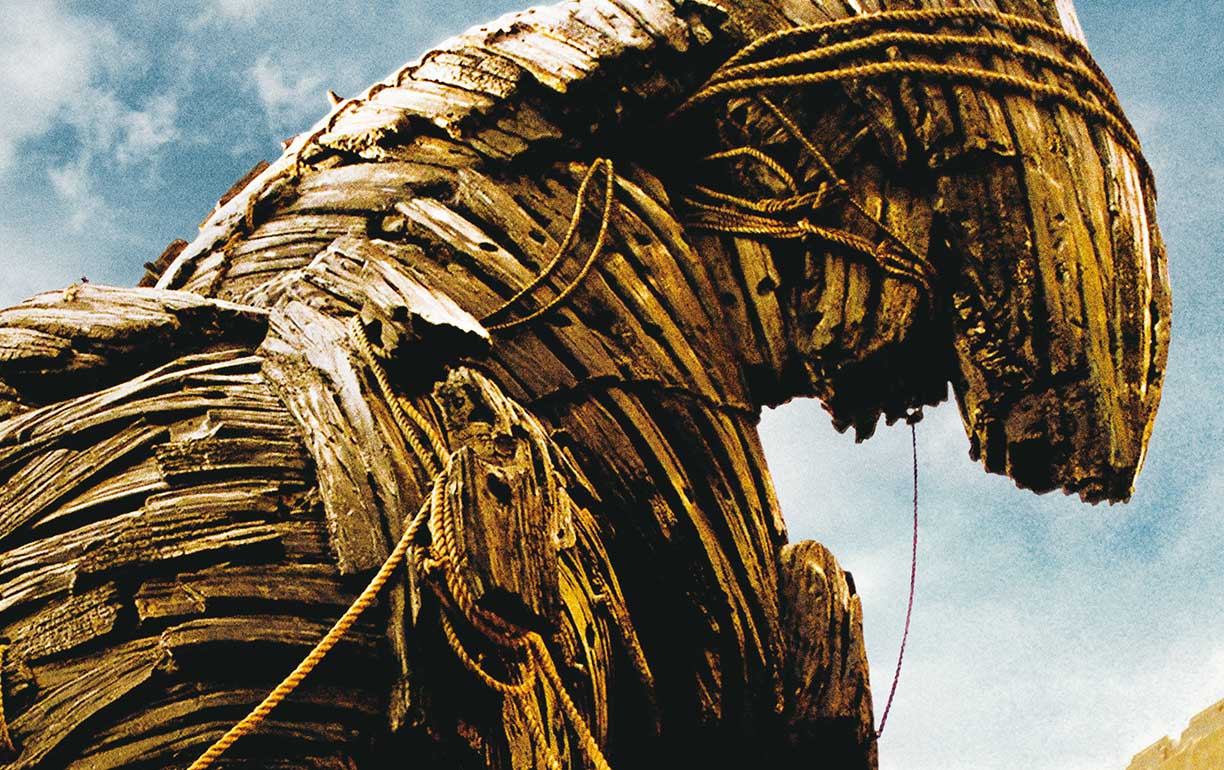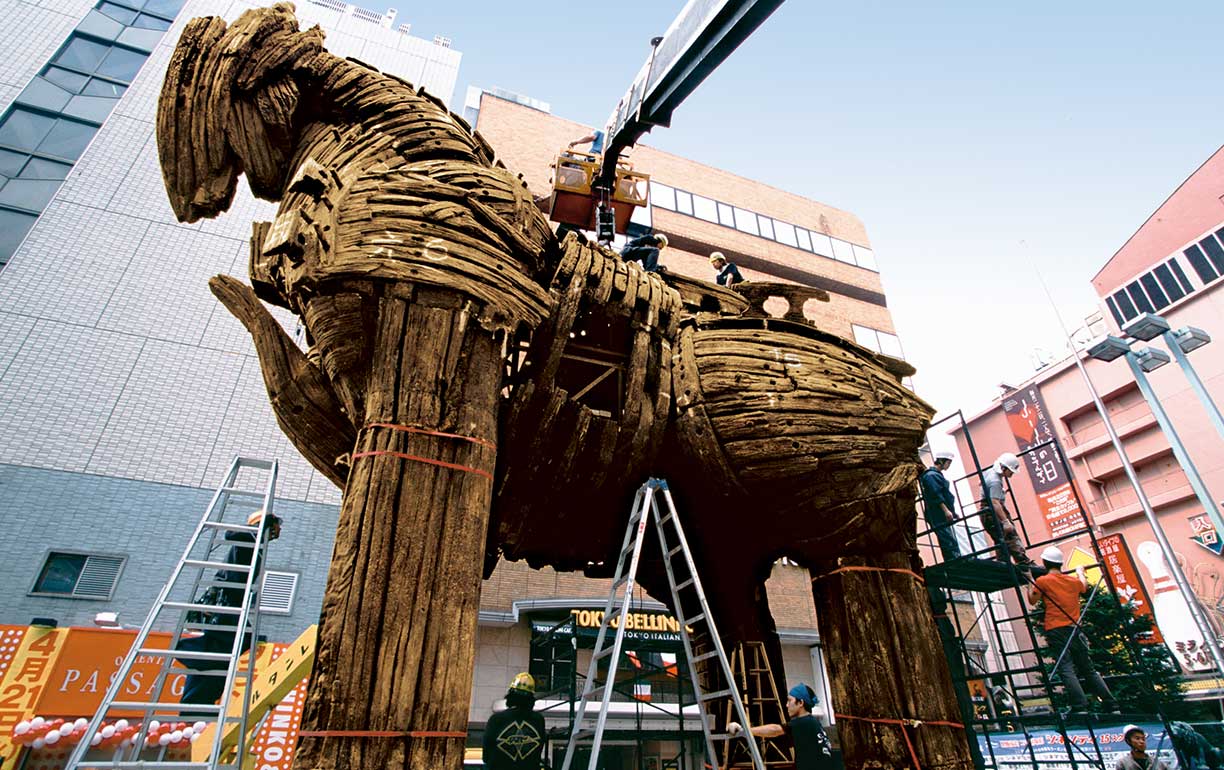
Flying legend.
With his film about the Trojan War, Wolfgang Petersen has created yet another box-office blockbuster. One of the film stars alongside Brad Pitt was the huge Trojan Horse. Lufthansa Cargo flew it to Tokyo following the European premiere.
Like a captive animal, the black colossus stands amidst the narrow canyon of houses. Busy activity prevails all around it. Numerous folding ladders are ready for use, men with protective helmets get to grips with the huge figure on two yellow work platforms.

They hammer, lash and push individual parts into the right position. There is no time to waste, since the erection of the Trojan Horse has to be completed in four days’ time. Together with the ships, the legendary figure is probably the biggest prop in the historical epic “Troy” filmed by Wolfgang Petersen.
Here, in “Cinema City Tokyo”, it is to be displayed as a prominent promotional vehicle for six weeks. Petersen chose no less a person than Brad Pitt to play the role of Achilles and Orlando Bloom as Paris. Over 1,000 extras were engaged for the 160 million dollar production. The film locations were Malta and Mexico.
A leading role was also played by the Trojan Horse, which seemed to have actually been constructed from the remnants of the planks of ancient vessels. In reality, however, it is made of painted fiberglass and steel beams – weighing twelve tons and measuring twelve by eleven meters.
These dimensions were definitely something special for Lufthansa Cargo, which transported the film star to Tokyo in collaboration with its WOW partner JAL Cargo. The Trojan Horse had recently been on display for the European premiere at the Sony Center on Potsdam Square in Berlin.
For transportation, it had to be disassembled and taken to Frankfurt by truck. The parts were then distributed between three freighter aircraft to be flown to Tokyo. Director Wolfgang Petersen hardly needed to worry about such logistical challenges. He focused on the cinematic adaptation of the stuff of legend.
The plot: The Trojan prince Paris falls in love with the Greek queen Helen and takes her with him to Troy. The aggrieved king of Sparta, Menelaos, subsequently goes to war against Troy with his best warriors, including Achilles and Odysseus. After unsuccessfully laying siege to the city for ten years, the Greeks appear to give up and sail away. As a “gift of conciliation” they leave behind a huge horse made of planks on the beach, in which 30 of their best soldiers are hidden.
The Trojans open the city wall gates, drag the horse inside and seal their downfall: at night, the enemy warriors leave their hideaway and, together with the Greeks who had again landed, raze Troy to the ground. Perhaps the Trojans should have put more faith in the words of the priest of Apollo, Laokoon, who, according to Virgil’s Aeneid, warned them about the gift from the Danaeans: “Quidquid id est, timeo Danaos et dona ferentes” (Whatever it is, I fear Greeks even when they bring gifts).
Photos:
Warner Bros.
planet 3/2004
|
A leading role was also played by the Trojan Horse, which seemed to have actually been constructed from the remnants of the planks of ancient vessels. In reality, however, it is made of painted fiberglass and steel beams – weighing twelve tons and measuring twelve by eleven meters. These dimensions were definitely something special for Lufthansa Cargo, which transported the film star to Tokyo in collaboration with its WOW partner JAL Cargo. The Trojan Horse had recently been on display for the European premiere at the Sony Center on Potsdam Square in Berlin. For transportation, it had to be disassembled and taken to Frankfurt by truck. The parts were then distributed between three freighter aircraft to be flown to Tokyo. Director Wolfgang Petersen hardly needed to worry about such logistical challenges. He focused on the cinematic adaptation of the stuff of legend. |
The plot: The Trojan prince Paris falls in love with the Greek queen Helen and takes her with him to Troy. The aggrieved king of Sparta, Menelaos, subsequently goes to war against Troy with his best warriors, including Achilles and Odysseus. After unsuccessfully laying siege to the city for ten years, the Greeks appear to give up and sail away. As a “gift of conciliation” they leave behind a huge horse made of planks on the beach, in which 30 of their best soldiers are hidden. The Trojans open the city wall gates, drag the horse inside and seal their downfall: at night, the enemy warriors leave their hideaway and, together with the Greeks who had again landed, raze Troy to the ground. Perhaps the Trojans should have put more faith in the words of the priest of Apollo, Laokoon, who, according to Virgil’s Aeneid, warned them about the gift from the Danaeans: “Quidquid id est, timeo Danaos et dona ferentes” (Whatever it is, I fear Greeks even when they bring gifts). |
Photos:
Warner Bros.
planet 3/2004
